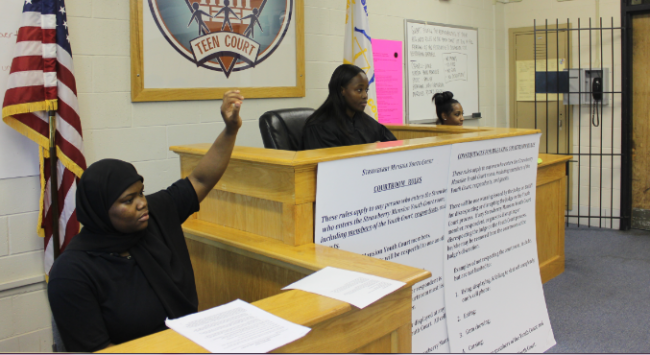Spotlight on Student Public Service & Pro Bono: Restorative Justice at Strawberry Mansion High
Every year, we honor law student pro bono with the PSJD Pro Bono Publico Award. Any 2L or 3L who attends a PSJD subscriber school and has significant pro bono contributions to underserved populations, the public interest community and legal education is eligible for nomination.
Today, Christina is in Philadelphia presenting the Pro Bono Publico award to our 2014-15 recipient, Alex Dutton. Alex, a student at Temple University Beasley School of Law, receives this year’s award for his work supporting Youth Court programs throughout the city of Philadelphia, beginning with his involvement at Strawberry Mansion High School.
Restorative Justice at Strawberry Mansion High
Alex Dutton, PSJD Pro Bono Publico Award Recipient, 2014-2015
(Temple University Beasley School of Law)–
Strawberry Mansion High School, “Mansion” as it’s known in the community, is a behemoth of a building that consumes several city blocks at the corner of 31st Street and Ridge Avenue in North Philadelphia. Across the street are abandoned rowhomes, collapsing in upon themselves. Students, dressed in collared shirts and khakis, scurry over jagged sidewalks under the shadows of the school’s immense façade. Walking past the police car eternally parked on Ridge Avenue in front of the school, they file in through the front doors. They wait to be screened by the metal detector. Some of the students make it to the courtroom on the third floor on time, others straggle in late. Always, the law students and attorneys are there, waiting, in this gem of a room (fitted with a jury box, witness stand, and bench) in the corner of a forgotten school in a forgotten neighborhood. From the jury box, one can just barely make out the top of the William Penn statute that stands atop Philadelphia’s City Hall. Eventually, a diminutive young lady, cloaked in a long black robe, adjourns the court.
No Right to Be Heard: Suspension Law and Due Process
Pennsylvania law provides effectively zero process for students suspended for three days or less. In contrast, state law, pursuant to the Federal Constitution, requires school districts to provide formal process to students at risk of expulsion. 22 Pa. Code § 12.8(b). In Philadelphia, a consent decree compels the School District of Philadelphia (“the District”) to provide similar procedural rights to students at risk of transfer to a disciplinary school. Dunmore v. School Dist. of Philadelphia, No. 72-43 (E.D. Pa, Feb. 14, 1973). That same consent decree requires the District to hold a conference with students suspended on a short-term basis. This conference is meant to provide staff, by speaking with the student, an opportunity to identify the student’s problematic behaviors and implement corrective techniques. (Recall: this is still more than most students get in Pennsylvania, because of Dunmore.)
There are nearly 200,000 students in Philadelphia. Cuts at the state level critically reduced funding for educational support staff, including guidance counselors and conflict resolution specialists. As a result, these student conferences are perfunctory, if they are happening at all. (I’m careful not to place blame with the District here; the District has done—and continues to do—a tremendous job reforming the process it provides students who are at risk of disciplinary transfer.) Most students are just sent home with suspension paperwork and told to come back in a day or two. In addition, many students are constantly funneled through in-school suspension—as damaging as a traditional exclusion—without any meaningful process or opportunity to be heard.
While this gap in due process may seem insignificant, it means schools suspend significantly more students than they might if each case were more carefully considered. Research has long demonstrated that students who are suspended fare much worse than their peers. Short-term suspensions are the entry point to the school-to-prison pipeline. Suspensions lead to more suspensions, which precipitate expulsions and dropout, eventually pushing students into the juvenile and criminal justice systems. What’s more, recent research posits that students who remain in the classroom when their peers are suspended are worse off, too.[1] Youth courts purport to fill this gap in due process, staffed with the greatest resource in the District: students.
Youth Courts and Restorative Justice
There are various models for youth courts. Some use a traditional adversarial approach, assigning students to the roles of prosecutor and defense counsel. Others use restorative justice techniques. Restorative justice de-emphasizes school exclusion and challenges students to think constructively about conflict resolution. At Strawberry Mansion, we used a restorative model.
When we first introduced restorative justice principles, our students were lost. During a “mock” hearing, the jury wanted to force their peer “respondent” to clean the bathroom with a toothbrush for talking back to a teacher. This, coming from students whose families had been ripped apart by the criminal and family justice systems? (Just weeks earlier a student told a federal prosecutor that “all prosecutors and judges should burn in hell!”) I couldn’t believe it. I took a step back and thought to myself: Alex, you’re so naïve. How could you ever expect anyone to respond in any other way other than what they’ve been taught, what they’ve learned through experience? Our students were raised on punitive discipline. In school, they were suspended and expelled. On the streets, they were arrested and sent away. So when we elevated our students to figures of authority, they reflected these punitive inclinations.
It was up to us to help our students question their assumptions about justice and conflict resolution. We pressed our students to think about the impact of rules and the policies behind them. Specifically, we encouraged them to consider the purposes of punishment, with a sharp focus on rehabilitation and restoration. Why is making a student clean the bathroom an appropriate punishment for acting out in class? How does the punishment relate to the harm the student caused to his classmates? They applied these concepts in the hearings.
Our far-reaching goal is that students will apply these principles to their daily lives, in school and in their communities. In the meantime, the youth court provided an opportunity for student-respondents, previously silenced under more primitive discipline regimes, to be heard. In addition to providing process, the youth court destabilized the school-to-prison pipeline at Mansion: if the respondent completed his restorative assignment, the offense would be wiped from his record. More importantly, he stayed in school. Rather than being alienated from his peers, he engaged with them.
A Day in the Life of the Strawberry Mansion Youth Court: Lawyering Skills Alive in the Classroom
Student-respondents who appear before their peers must admit responsibility for violating the school code. (And, really, these are minor infractions: cell phone use, uniform violations, talking in class, walking the halls, refusing to do school work, arguing with another student, arriving late to class.) Effectively, the youth court process is a dispositional hearing; peer questioning exposes facts relevant to determining an appropriate punishment—the restorative assignment.
Prior to the hearing, the respondent meets with his “youth advocate,” a high school student trained to defend him. With the assistance of a law student, the youth advocate interviews her peer-client. She listens to him. She inquires as to his motivations and what he thinks the appropriate punishment should be. She levels with him when he is unreasonable. Then, she presents this information to the jury: an opening statement. Through this process, students learn crucial listening skills and gain exposure to public speaking.
Next, the judge opens the floor for questions from the jury. To facilitate greater class participation, the jurors ask their peer-respondent questions. The jurors proceed, guided by the Mansion Court’s mantra: FACTS. HARM. FIX IT. Through questioning, the jurors attempt to uncover the facts of the case, the harm caused to the community by their peer’s conduct, and possible constructive solutions. By uncovering the facts of what happened, the students assessed his culpability. By inquiring into harm, the jurors determined the segments of the community that were affected and ripe for restoration. As they go, the students fill out charts labeled: FACTS. HARM. FIX IT. Their questions forced their peer to critically examine the consequences of his actions and included the him in the restorative process: “now that you have identified the harm caused, if any, what can you do to repair that harm, to restore our school community?”
We provided the high school students with the skills they needed to conduct this process. We trained them in questioning techniques: open-ended and closed-ended questions, funneling, etc. We exposed them to principles of restorative justice. And we trained them to be good listeners. (These are all skills that are often overlooked in law school.)
 Together, the students guide their peers through the restorative process, making objections and requesting sidebars–concepts the Youth Court program staff never taught.
Together, the students guide their peers through the restorative process, making objections and requesting sidebars–concepts the Youth Court program staff never taught.(Photo courtesy of Alex Dutton)
Together, the students guide their peers through the restorative process. Every now and then, the youth advocate stands up: “Your Honor, they keep asking my client the same questions; make them move on to a solution.” An objection! The foreman disagrees: “we are trying to get to the bottom of what happened.” The judge is concerned: “can you two come over here to talk with me.” A sidebar! We never taught these concepts. The students, empowered with the skills to resolve disputes, improvised. Advocates called out unfairness; jurors objected because they were untangling important and difficult aspects of the case; judges adjusted to ensure civility and efficiency. All of this to ensure that their peer received his day in their courtroom.
Eventually, the jury returns a verdict: a parent conference so that the school knows the student’s father plans to call the school in the morning to make sure his daughter arrived safely. Why? She had been stepping out of the classroom each morning to pick up her father’s call.
Final Remarks
Of course, youth courts are far from the only solution to the school pushout problem. In my view, school districts should adopt a variety of interventions—some restorative, some not—that would collectively transform schools from punitive institutions to compassionate, empowering communities. Our schools expend so much energy excluding students from school, just to kick the can down the road—to another school, or worse, to our public dependency systems, including prison. Why not spend this energy empowering our students?
My charge to future law students and lawyers is this: be creative, be bold! Youth courts provide a platform for young people to reform their schools; a legal education is your platform to improve your community.
[1] Brea L Perry & Edward W. Morris, Suspending Progress: Collateral Consequences of Exclusionary Punishment in Public Schools, 79 No. 7 American Sociological Review 1067 (December 2014).

